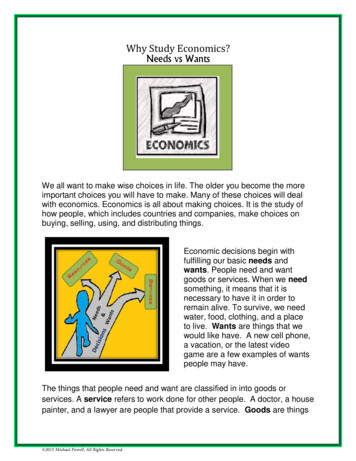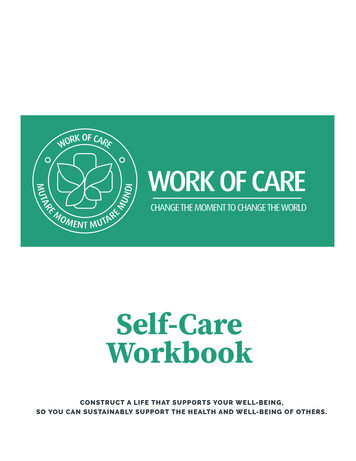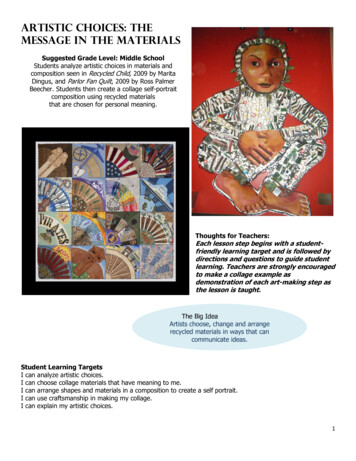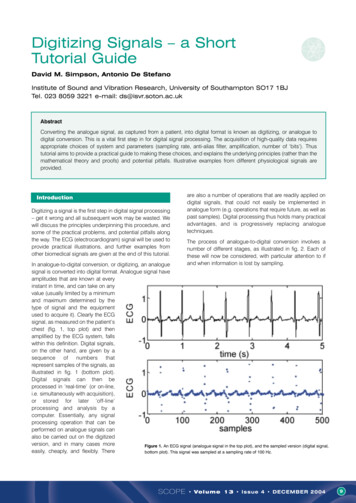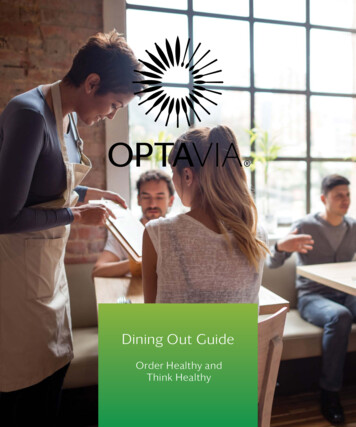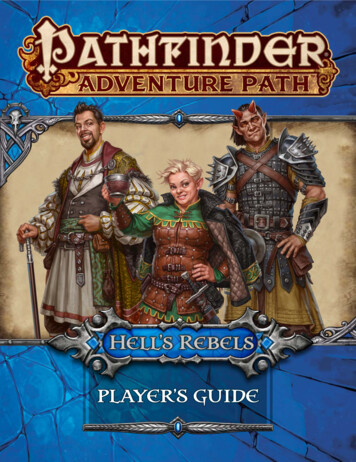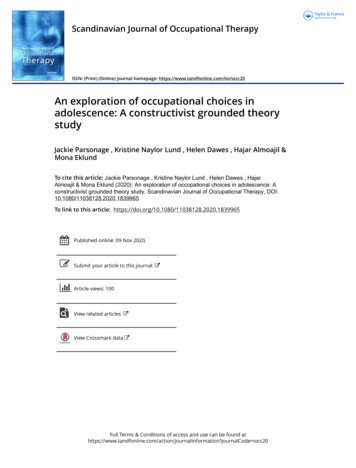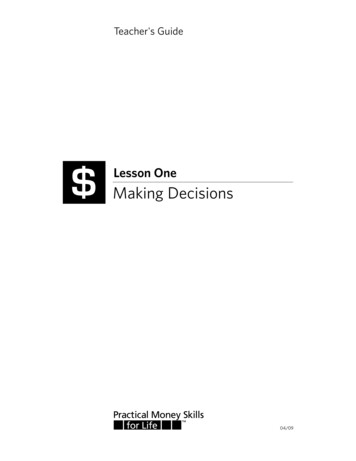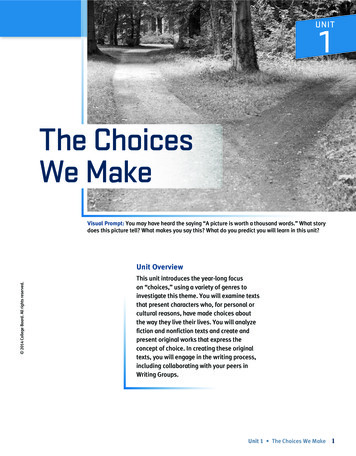
Transcription
UNIT1The ChoicesWe MakeVisual Prompt: You may have heard the saying “A picture is worth a thousand words.” What storydoes this picture tell? What makes you say this? What do you predict you will learn in this unit? 2014 College Board. All rights reserved.Unit OverviewThis unit introduces the year-long focuson “choices,” using a variety of genres toinvestigate this theme. You will examine textsthat present characters who, for personal orcultural reasons, have made choices aboutthe way they live their lives. You will analyzefiction and nonfiction texts and create andpresent original works that express theconcept of choice. In creating these originaltexts, you will engage in the writing process,including collaborating with your peers inWriting Groups.Unit 1 The Choices We Make1
1The Choices We MakeGOALSContents To analyze genres and theirorganizational structuresActivities To examine the function ofnarrative elements1.1Previewing the Unit . 41.2Exploring the Concept of Choice . 51.3Choices and Consequences: Paired Poetry . 9Poetry: “The Road Not Taken,” by Robert FrostPoetry: “Choices,” by Nikki Giovanni1.4Exploring the Personal Narrative .14Novel: Excerpt from Staying Fat for Sarah Byrnes,by Chris CrutcherIntroducing the Strategy: Metacognitive Markers1.5Analyzing Incident, Response, Reflection .18Autobiography: from Dust Tracks on a Road, by ZoraNeale Hurston1.6Analyzing Language .21Memoir: from Bad Boy, by Walter Dean Myers1.7Timed Writing: Choosing a Topic and Drafting aPersonal Narrative . 281.8Once Upon a Time: Revising the Beginning .311.9Can You Sense It? Revising the Middle . 33Personal Narrative: “Why Couldn’t I Have Been NamedAshley?” By Imma AchilikeIntroducing the Strategy: Looping1.10Tie It Together: Revising the Ending . 39 To apply techniques tocreate coherence andsentence variety in writing To apply revision techniquesin preparing drafts forpublicationACADEMIC rnal coherenceexternal coherencethememetaphorobjectivesubjectiveLiterary ory detailsfigurative ective camera anglesubjective camera angle2Embedded Assessment 1:Revising a Personal NarrativeAbout Choice .411.11Previewing Embedded Assessment 2:Expanding Narrative Writing .431.12Poor Choices: “Phaethon” .47Myth: “Phaethon,” by Bernard Evslin1.13Flight to Freedom . 58Myth: “Daedalus and Icarus,” from Greek Myths by GeraldineMcCaughreanIntroducing the Strategy: DiffusingSpringBoard English Language Arts Grade 7 2014 College Board. All rights reserved.UNIT
1.14A Matter of Pride . 64Myth: “Arachne,” by Olivia E. Coolidge1.15Symbolic Thinking . 681.16Animals as Symbols: Aesop’s Fables .71Fable: “The Lion, the Fox, and the Stag,” from Aesop’s Fables1.17Analyzing Visual Techniques .74*Film Clip: The Mighty, directed by Peter Chelsom1.18Creation Myths from Around the Globe . 77Informational Text: “A Note from the Author,” by Virginia HamiltonMyth: “Huveane and Clay People,” from Voices of the Ancestors:African Myth, by Tony Allan, Fergus Fleming, and Charles PhillipsMyth: “Mbombo,” from Voices of the Ancestors: African Myth, byTony Allan, Fergus Fleming, and Charles PhillipsMyth: “Raven and the Sources of Light,” by Donna RosenbergEmbedded Assessment 2:Language and WritersCraft Verb Tenses (1.5) Creating Coherence andSentence Variety (1.6) Analogies (1.7) Coherence (1.7) Punctuating CoordinateAdjectives (1.9) Pronouns andAntecedents (1.14)Creating an Illustrated Myth. 83 2014 College Board. All rights reserved.*Texts not included in these materials.Unit 1 The Choices We Make3
ACTIVITY1.1Previewing the UnitLEARNING STRATEGIES:QHT, Collaborative Groups,SummarizingLearning Targets Preview the big ideas and vocabulary for the unit. Identify and summarize the knowledge and skills necessary to completeEmbedded Assessment 1 successfully.Making ConnectionsMy NotesIn this unit, you will read a variety of genres, including poetry, autobiography,memoir, myth, and fable. You will also learn more about personal narratives andwill write and revise one of your own. By the end of the unit, after studying mythsand fables, you will also write and illustrate a myth. Before starting the unit,answer the Essential Questions that follow.Essential QuestionsBased on your current knowledge, how would you answer these questions?Effect and effective are wordsyou will encounter often inacademic courses. When wetalk about the effect of changesor the effect of a metaphor, weare referring to the way onething acts upon another. Sowe are asking you to be ableto describe how one thinginfluences another. The adjectiveeffective refers to somethingthat is successful in producing adesired or intended result.Developing VocabularyLook again at the Contents page and use a QHT strategy to analyze and evaluateyour knowledge of the Academic Vocabulary and Literary Terms for the unit.Unpacking Embedded Assessment 1Read the assignment for Embedded Assessment 1: Revising a Personal Narrativeabout Choice. While reading, underline or highlight key skills and knowledge youwill need to be successful with the assignment.Your assignment is to revise the personal narrative with reflection youpreviously drafted. Use the revision techniques you have learned in this unit,including meeting in a Writing Group, to improve the beginning, middle, and endof your narrative. You will also write a text explaining the revisions you made toimprove your first draft and the effect of the changes on the final piece.Paraphrase what you will need to know to complete this assessment successfully.With your class, create a graphic organizer to represent the skills and knowledgeyou will need to complete the tasks identified in the Embedded Assessment.INDEPENDENTREADING LINKThe first half of this unit willfocus on personal narratives.Choose from the genresof memoir, biography, orautobiography to read duringthis unit. Select a book thatlooks interesting to you andseems manageable.4SpringBoard English Language Arts Grade 7 2014 College Board. All rights reserved.ACADEMIC VOCABULARY1. How do authors use narrative elements to create a story?2. What are the elements of effective revision?
Exploring the Concept of ChoiceLearning TargetsACTIVITY1.2LEARNING STRATEGIES: Paraphrase and analyze quotes related to choices. Consider choices for independent reading.Brainstorming, ParaphrasingParaphrasing Ideas1. In the graphic organizer below, paraphrase each quote in the first column andwrite a personal response to the quote in the second column. Remember that toparaphrase means to put information in your own words.Read and ParaphraseWhat is the author saying?Personal ResponseTo what extent do you agree or disagree withwhat the author is saying about choice?1. “Life is the sum of all your choices.”— Albert Camus2. “While we are free to choose our actions, we arenot free to choose the consequences of our actions.”— Stephen R. Covey 2014 College Board. All rights reserved.3. “The strongest principle of growth lies in humanchoice.” — George Eliot4. “The last of the human freedoms is to choose one’sattitude.” — Victor Frankl5. “The ultimate measure of a man is not where hestands in moments of comfort and convenience, butwhere he chooses to stand at time of challenge andcontroversy.” — Dr. Martin Luther King, Jr.6. “I believe the choice to be excellent begins withaligning your thoughts and words with the intention torequire more from yourself.” — Oprah WinfreyUnit 1 The Choices We Make5
ACTIVITY 1.2Exploring the Concept of ChoicecontinuedLEARNING STRATEGIES:Brainstorming, ParaphrasingLiterary TermsA literary genre is the categoryor class to which a literarywork belongs; epic poetry,mythology, and science fictionare all examples of literarygenres.My NotesYour Choices as a Reader One choice that you will make is what you will readin your own time. Respond to the following questions in your Reader/WriterNotebook.2. Think about the content of your favorite books. What have you enjoyed reading in the past? What is your favorite book, favorite type of book, or favorite author?3. Think about the manageability of the texts you have enjoyed reading in the past. How do you feel about long books? Do you like a novel with short chapters or longer sections? What was the last book you read from cover to cover? Do you usually read a book in one or two days or does it take you longer tofinish a book?4. Do you have a favorite genre?Read the first few pages. Does this seem interesting? Does the text make sense so far? Does this seem too hard, too easy,or just right?After considering the content andpurpose of the independent readingin this unit, do you want to continuereading the book you chose or choosesomething else?6SpringBoard English Language Arts Grade 7 2014 College Board. All rights reserved.Preview the book you’ve selected: What do the front and back covershow you? What type of visual is shown? What types of fonts and colors areused? Are there awards or brags? What dothey say? What do these elements tell youabout the book?
ACTIVITY 1.2continued5. Create an INDEPENDENT READING PLAN for the text you have chosen. I have chosen to readMy Notesbybecause I will create time to read by I should finish this text byAs you read, think like a writer; notice the way the author tells his or her own story(in a memoir or autobiography) or the story of the subject (in a biography). Yourteacher may ask you to respond to your reading by asking you specific questionsabout your text. You may also have the opportunity to apply a specific skill orstrategy you’ve practiced in class to your independent reading.Your Choices as a Writer6. What types (genres) of texts do you enjoy writing the most?7. What types (genres) of texts do you enjoy writing the least? 2014 College Board. All rights reserved.8. Do you choose to write outside of school? Explain.9. Examine the chart on the next page. Why is writing a process? What part(s) of the writing process are you most familiar with? What part(s) of the writing process are you least familiar with?Unit 1 The Choices We Make7
ACTIVITY 1.2Exploring the Concept of ChoicecontinuedWriting as a ProcessMy NotesTopic sFreewritingGenerateIdeasRevisionExamineModel te-takingInterviewingLiteratureDramaMusicEdit Punctuation Spelling AestheticsPublishYOUR WRITING GOALSSkills I hope to grow:Preparing Your Portfolio Your portfolio will be a place for you to collect, review,and revise the work you do during each unit of instruction. Use your brainstormingabout choice, the quotes, your response to the quotes, and your reflection,planning, and goal setting as a reader and writer to create a portfolio cover.Creatively express your ideas. The largest thing on your cover should be the word“Choice.”8SpringBoard English Language Arts Grade 7 2014 College Board. All rights reserved.Writing strengths that I plan tocontinue:
Choices and Consequences:Paired PoetryLearning Targets Analyze choices and consequences presented in a text. Analyze and compare diction choices in two different texts on the same topic.Before ReadingACTIVITY1.3LEARNING STRATEGIES:Activating Prior Knowledge,Webbing, Marking theText, Close Reading,Brainstorming, Drafting1. In the poem you will be reading, the narrator comes to a “fork in the road.” Thisis an example of figurative, not literal, language, as the phrase does not refer toan eating utensil in a driving lane. How would you describe a “fork in the road”?My Notes2. In your Reader/Writer Notebook, create a web titled “My Choices” to brainstormthe choices you have faced and decisions you have made in your life. Thinkabout large and small choices from the past and in the present. You will returnto this web throughout the unit.Add these ideas to the second section of your portfolio cover. Use words,phrases, or pictures, and then label this section “personal choices.” 2014 College Board. All rights reserved.3. Poetry is a literary form you probably have had experience with as a readeror writer or both. What do you know about poetry as a literary form? How is itdifferent from prose writing?Literary TermsA word’s denotation isits exact, literal meaning.Connotation is thesuggested or impliedmeaning or emotionassociated with a word,beyond its literal definition.A stanza describes adivision of lines into equalgroups. Robert Frost’s“The Road Not Taken” isdivided into 4 stanzas of5 lines each.Like narratives, poetry is written from a point of view. Remember thatfirst-person point of view is written from a character’s point of view and useswords like “I,” “me,” and “mine.” Third-person point of view is written from anarrator’s point of view and uses works like “he,” “she,” and “they.”During Reading4. Mark the text by highlighting or underlining unfamiliar words. Marking thetext helps you engage in close reading and organize your textual evidenceafter reading. During your second reading, paraphrase each stanza. It is alsoimportant to examine both denotation and connotation of unfamiliar words as apart of close reading.WORDCONNECTIONSRoots and AffixesNarrative comes from the Latinword narrare, which means“to tell” or “to make known.”The root narra- appears inthe English words narrate,narration, and narrator.Unit 1 The Choices We Make9
ACTIVITY 1.3continuedGRAMMARChoices and Consequences:Paired PoetryUSAGEPunctuationWriters use punctuation inpoetry to cluster ideas andcommunicate meaning for thereader. A period ends a thoughtand creates dramaticeffect. An exclamation pointadds emphasis. The semicolon combinestwo like ideas withoutadding the finality of aperiod. The comma marks apause and may buildon or clarify somethingpreviously stated. The dash indicatesanticipation of somethingto follow.ABOUT THE AUTHORRobert Frost (1874–1963) was one of America’s most popular twentiethcentury poets. For much of his life, he lived on a farm in New Hampshire andwrote poems about farm life and the New England landscape. His apparentlysimple poems, however, have many layers of meaning.PoetryThe RoadNot Takenby Robert FrostTwo roads diverged in a yellow wood,And sorry I could not travel bothAnd be one traveler, long I stoodSummarize each stanza ofthe poem, and then explainhow the poem’s meaningis developed through theprogression of the fourstanzas.My NotesAnd looked down one as far as I could5 To where it bent in the undergrowth;Then took the other, as just as fair,And having perhaps the better claimBecause it was grassy and wanted wear,Though as for that the passing there10 Had worn them really about the same,And both that morning equally layIn leaves no step had trodden black.Oh, I marked the first for another day!Yet knowing how way leads on to way15 I doubted if I should ever come back.I shall be telling this with a sighSomewhere ages and ages hence:Two roads diverged in a wood, and I,I took the one less traveled by,20 And that has made all the difference.10SpringBoard English Language Arts Grade 7 2014 College Board. All rights reserved.KEY IDEAS AND DETAILS
ACTIVITY 1.3continuedABOUT THE AUTHORNikki Giovanni is a popular poet and professor of English. Over the years, shehas won numerous writing awards. Her writing often focuses on individualsand their choices to make a difference.My NotesPoetryChoiceshoi esby Nikki Giovanniif i can’t dowhat i want to dothen my job is to notdo what i don’t want5 to do 2014 College Board. All rights reserved.it’s not the same thingbut it’s the best i candoif i can’t have10 what i want . . . thenmy job is to wantwhat i’ve gotand be satisfiedthat at least there15 is something moreto wantsince i can’t gowhere i needto go . . . then i must . . . goKEY IDEAS AND DETAILSExamine Giovanni’s diction.Notice the choice of theword jobjob. Use resources tolook up the denotation ofthis word, and then thinkabout the connotation ofthe word. How does it addto a sense of Giovanni’stone or attitude?KEY IDEAS AND DETAILSNotice how each stanzais set up in a similar way,beginning with an adverbialclause (if I can’t . . . ;since I can’t . . . ; when Ican’t . . . ) followed by a“then . . .” phrase.Summarize each stanza toshow their similarities inmeaning.20 where the signs pointthough always understandingparallel movementisn’t lateralwhen i can’t express25 what i really feeli practice feelingwhat i can expressand none of it is equali know30 but that’s why mankindalone among the animalslearns to cryUnit 1 The Choices We Make11
continuedMy NotesChoices and Consequences:Paired PoetryAfter Reading5. Use the graphic organizer to compare and contrast the two poems.“The Road Not Taken”12“Choices”Examples of connotative diction andimplied meaning/emotionExamples of connotative diction andimplied meaning/emotionWhat do you notice about how thespeaker responds to “choice” in thispoem?What do you notice about how thespeaker responds to “choice” in thispoem?Theme: What is the message aboutlife implied in this poem?Theme: What is the message aboutlife implied in this poem?SpringBoard English Language Arts Grade 7 2014 College Board. All rights reserved.ACTIVITY 1.3
ACTIVITY 1.3continuedCheck Your UnderstandingWriting Prompt: Use evidence from the text and your analysis to complete theMy Notessentence starter below. Be sure to: Use precise language when referring to the poems. Start your paragraph with a topic sentence that finishes the sentence starter.My attitude about “choices” is most like the speaker from (Frost’s poem “A RoadNot Taken” or Giovanni’s poem “Choices”) because . . .Choices and Consequences 2014 College Board. All rights reserved.Many choices have consequences. Create a web to explore the meaning ofconsequences. What synonyms do you know? Consult a dictionary or thesaurus tohelp you find synonyms.ACADEMIC VOCABULARYWhen discussing theconsequences of anaction, you are referring tosomething that logicallyor naturally follows froman action or condition. Butif you say “money is of noconsequence to me,” youare using the word to mean“importance” or “relevance.”ConsequencesGo back to your “My Choices” web and add the consequences for the choicesyou labeled. Some choices may have several consequences. Add just the mostimportant ones that resulted from your choice.Unit 1 The Choices We Make13
ACTIVITY1.4Exploring the Personal NarrativeLEARNING STRATEGIES:Activating Prior Knowledge,Graphic Organizer, Note-taking,Metacognitive MarkersLearning Targets Identify the components that provide the organizational structure of a personalnarrative. Write a narrative that includes an incident, a response, and a reflection.Before ReadingMy Notes1. Complete the graphic organizer below to explore your prior knowledge aboutpersonal narratives. You have read narratives in earlier grades. A personalnarrative tells a story about something that happened in the writers’ life.Exploring Personal NarrativesWith what kinds ofnarrative texts are youfamiliar?A narrative tells a story ordescribes a sequence ofevents in an incident.What are some of yourfavorite narratives?Explain what makesreading a narrativeenjoyable.What elements would youexpect to find in a goodstory?What is the purpose of anarrative?14SpringBoard English Language Arts Grade 7 2014 College Board. All rights reserved.Literary Terms
ACTIVITY 1.4continuedIntroducing the Strategy: Metacognitive MarkersUsing metacognitive markers involves marking the text with symbols to reflectthe thinking you are doing as you read. After reading, you can scan the textand use your metacognitive markers to quickly find evidence when you aretalking or writing about a text. Here are the markers:?!*My NotesUse a question mark for questions you have about the text.Use an exclamation point for a reaction to what you are reading.Use an asterisk for a comment about the text.Use an underline to identify a key idea or detail in the text.During ReadingAs you read “Staying Fat for Sarah Byrnes,” use metacognitive markers to interactwith the text.ABOUT THE AUTHORChris Crutcher grew up in Idaho and now lives in Washington State. A highlyrespected writer of novels for young adults, Crutcher has won awards for hisfiction, much of which takes place against sports backgrounds. He likes toplace characters in realistic and difficult situations and explore what drivesthese characters as they are forced to make tough choices.Novel Excerpt 2014 College Board. All rights reserved.Staying Fatby Chris Crutcherfor Sarah ByrnesChunk 1When I got to the field for our first game, I was so excited I thought I wouldthrow up. I hadn’t slept a wink the night before and spent the entire day throwingmy baseball against the side of the garage, grossly exaggerating the speed of thegrounders, dribbling back as I snapped them into the merciless trap of my gloveand threw the runner out.I didn’t catch one ball in warm-ups. They dropped to the right of me. Theydropped to the left of me. They hit my arms and fell harmlessly to the grass. But Iwas just so happy to be there, to belong with these other kids with ‘Junior Oilers’across their chests that it didn’t matter.Chunk 2When coach called us into a huddle before the umpire yelled, “Batter up!” hewent over our positions and the batting order one last time, but he didn’t need tofor my sake because I had memorized those things from the first practice. I battedninth. I played right field. I knew what that meant. I knew I was the very worsthitter on the team and the very worst fielder. But I didn’t care, because I had a newglove and a green-and-gold uniform and I belonged.Unit 1 The Choices We Make15
ACTIVITY 1.4Exploring the Personal NarrativecontinuedGRAMMARUSAGEConventionsA dash is used: to mark a parentheticalthought to indicate an unfinishedsentence to show an abrupt changein thought when a periodis too strong and a commais too weak.My NotesWe were the home team and batted the bottom half of the inning, so wetouched our gloves together in the middle of the huddle and yelled, “Go Oilers!”and broke to take our position. I was so proud. But before I got even to the baseline,Coach’s hand was on my shoulder, and when I turned around, Ronnie Callendarstood next to him. And he said, “I want you to give Ronnie your glove.”I said, “What for?”He said, “He doesn’t have one.”Chunk 3Coach watched my face fall—I know he did—and I think he knew how I feltbecause he was very kind, but he said, ‘Cindy, if we’re going to win this, Ronnie hasto have a mitt. A shortstop has to have a mitt, that’s just all there is to it.’ I lookedat the glove on my hand; I bit my lower lip while I read Warren Spahn’s name, andI handed it over. Coach told me to play as far back in right field as I could so noballs could get over my head—that I could run faster forward than backward—andsent me on my way. I walked so far back I almost disappeared into the playgroundswings beyond the field.Just that quick I didn’t belong, and I remember thinking something always hasto spoil it. I was hurt and embarrassed and I wanted to go back to being invisibleme again, but I couldn’t because I had on the green shirt and cap, and all of asudden that uniform was my enemy. I remember hating Ronnie Callendar for beingpoor, and I hoped his father never got a job and they’d have to move away.KEY IDEAS AND DETAILSSummarize the eventsleading up to the point whenthe narrator says “Just thatquick I didn’t belong . . .”After Reading3. During class discussion, use the graphic organizer on the next page to takenotes on the key parts of a personal narrative. Describe the incident in thisselection. Find textual evidence to support your ideas. Remember to use yourmetacognitive markers to find evidence in the text.4. Locate the narrator’s response to the incident. What does she say about herfeelings? Use textual evidence (a quote or a paraphrase) to support your ideas.16SpringBoard English Language Arts Grade 7 2014 College Board. All rights reserved.Every game after that was miserable. I couldn’t quit because we would haveonly eight players and all the kids would hate me. Coach didn’t always take myglove; in fact, I don’t know that he ever took it again. But each time I walked downthat hot, dusty summer road toward the playing field, I knew he might, that I didn’treally belong because they could take my glove.
ACTIVITY 1.4continuedIncident(what happened)Response(your feelings andthoughts about peopleinvolved at the time)Reflection(the lesson you learnedfrom this experience)5. Summarize the reflection in this selection. Looking back, how does the speakerunderstand the incident? Find textual evidence to support your ideas. How isthe reflection different from the response?Reflection(how you will use thislesson in the future)WORDCONNECTIONSRoots and AffixesReflection comes from theLatin prefix re- (“back”) andthe root flectere (“to bend”),so it carries the meaning of“bending or turning back.”When you reflect, you turnyour thoughts back to thinkagain about a subject. 2014 College Board. All rights reserved.My Notes6. Have you thought of additional choices since the last activity? Add them to your“My Choices” graphic organizer.7. Select a choice and freewrite about it as a way to explore the topic. Be preparedto share in a collaborative group. Be sure to: Explain the incident. (What was the choice? What took place when the choicepresented itself?) Fully discuss your response. (What did you choose? How did you react?) Communicate your reflection. (What did you learn from this choice and itsconsequences?)Check Your UnderstandingWrite a definition of a personal narrative.Unit 1 The Choices We Make17
Analyzing Incident, Response,ReflectionACTIVITY1.5LEARNING STRATEGIES:Activating Prior Knowledge,Graphic Organizer, Notetaking, Metacognitive Markers,Revisiting Prior Work, Webbing,Drafting, LoopingMy NotesLearning Targets Analyze a narrative work using incident, response, and reflection. Analyze the organizational structure of a personal narrative.Before Reading1. Quickwrite: Recall an early memory from childhood that stands out to you.Think about stories that your family has shared about you growing up. Forexample, what were some milestones (your first toy, bike, or game) or asignificant celebration or family event? Write freely to explore your memorywhile thinking about any choices you made.During Reading2. Use metacognitive markers to make mental notes as you read. Pay particularattention to any words or phrases that stand out to you as confusing, powerful,or interesting.ABOUT THE AUTHORBorn in 1891, Zora Neale Hurston was an American anthropologist andwriter. Hurston grew up in the small town of Eatonville, Florida, the firstincorporated black township. Hurston’s idyllic childhood was interrupted bythe death of her mother when Hurston was only 13. She struggled to finishhigh school, which she still had not accomplished by age 26. Despite herearly struggles, Hurston went on to graduate from Barnard College in 1928.She wrote several short stories and novels. Their Eyes Were Watching God isconsidered her master work. She died in 1960.GRAMMARUSAGEVerb TensesVerb tenses show time.Progressive tenses describea continuing action. You formthe progressive tenses witha form of the verb be and thepresent participle of the verb.For example, Hurston usesthe past progressive tense toindicate an ongoing action inthe past:“Everything was going alongall right . . .”“I was messing with . . .”18Dust Tracks on a Roadby Zora Neale HurstonBut nine months rolled around, and I just would not get on with the walkingbusiness. I was strong, crawling well, but showed no inclination to use my feet. Imight remark in passing, that I still don’t like to walk. Then I was over a year old,but still I would not walk. They made allowances for my weight, but yet, that was noreal reason for my not trying.They tell me that an old sow-hog taught me how to walk. That is, she didn’tinstruct me in detail, but she convinced me that I really ought to try.It was like this. My mother was going to have collard greens for dinner, soshe took the dishpan and went down to the spring to wash the greens. She left mesitting on the floor, and gave me a hunk of cornbread to keep me quiet. Everythingwas going along all right, until the sow with her litter of pigs in convoy came abreastof the door. She must have smelled the cornbread I was messing with and scatteringcrumbs about the floor. So, she came right on in, and began messing around.SpringBoard English Language Arts Grade 7 2014 College Board. All rights reserved.Autobiography
ACTIVITY 1.5continuedMy mother heard my screams and came running. Her heart must have stoodstill when she saw the sow in there, because hogs have been known to eat humanflesh. But I was not taking this thing sitting down. I had been placed by a chair, andwhen my mot
Your Choices as a Reader One choice that you will make is what you will read in your own time. Respond to the following questions in your Reader/Writer Not
